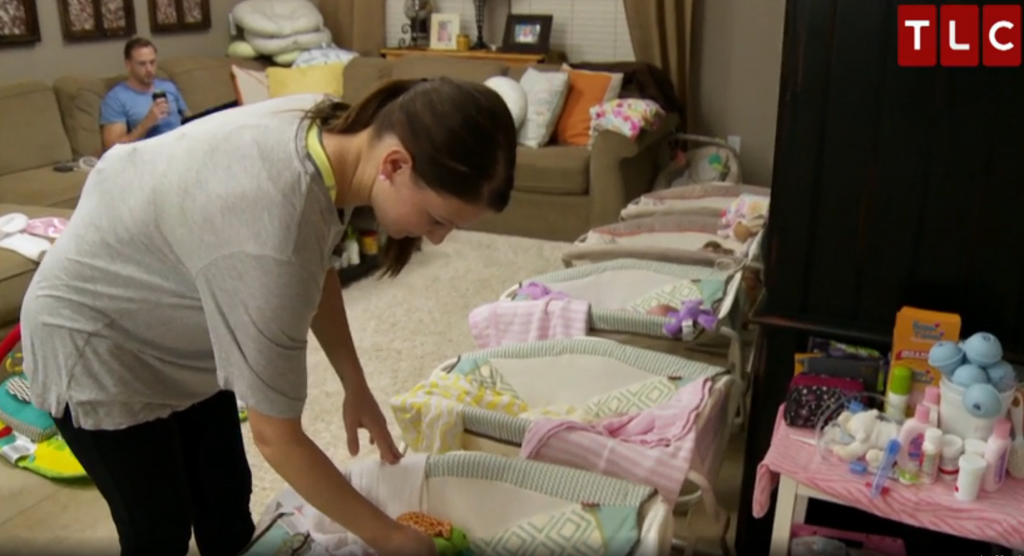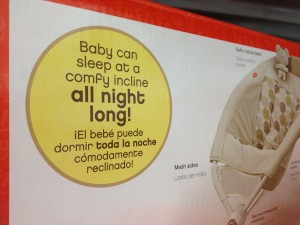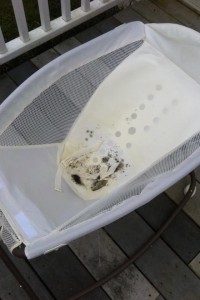Baby Sleeping on Side in Rock N Play
Update April 2019: The Consumer Product Safety Commission has RECALLED all Rock N Plays because of infant deaths! If you have one already, please stop using it.
This comes on the heels earlier this month of the government's previous warning to stop use of the product by three months of age, or as soon as an infant exhibits rollover capabilities. 10 deaths have been attributed to this product since 2015!
We first warned our readers of this product back in 2016—here is an archive of our work and research:
Last Updated: May 21, 2021 @ 7:06 pm. First Published: June 6, 2016. Fisher-Price Rock 'n Play sleeper: Miracle soother . . . or dangerous crutch? The Fisher Price Rock 'n Play sleeper is dangerous, in our opinion. In this article, we will lay out the case for why you shouldn't use an inclined sleep product like this.
But first, a bit of history—and how Fisher Price Rock 'n Play sleeper got so popular.
The Fisher Price Rock 'n Play sleeper is the ever-popular inclined sleeper, thanks in part to reality TV. Most recently, the Rock 'n Play starred on TLC's new reality show OutDaughtered. A recent episode featured their five baby girls sleeping in a row of—you guessed it—Fisher Price Rock 'n Play sleepers:

As a result of this and other publicity, this Fisher Price sleeper is reaching cult status—women are whispering about it in the aisles of baby stores, calling it a "miracle worker" that enables babies to sleep. And the Fisher Price Rock 'N Play occupies most of the best-seller list in Amazon's "bouncer" category.
At the same time, several pediatricians have taken to blogs to denounce the bouncer, calling it dangerous, a possible risk for SIDS among other maladies. Most seriously, according to a November 2018 article in the Wall Street Journal, inclined sleepers like the Rock 'N Play have been implicated in 30 deaths and 700 injuries since 2005.
So what exactly is the Fisher Price Rock 'n Play sleeper? And why is it controversial?
The Fisher-Price Rock 'n Play sleeper's pitch: "great for overnight sleep"?
The Fisher-Price Rock 'n Play sleeper debuted in 2009 and is billed as an "inclined sleeper." Baby is placed inside the sleeper, which has deep side walls to keep a baby snug. Fisher-Price touts the sleeper as "great for overnight sleep" (on its box) and "the inclined seat helps baby sleep all night long" (on FP's web site).
The instructions for the Rock 'n Play sleeper list a 25 lb. weight limit. The average (50% percentile) boy reaches 25 lbs. around 21 months of age. For girls, that same figure is 23 months.
The popularity of this product has lead Fisher-Price to release 36 different versions of the Rock 'n Play. While the basic Rock 'n Play has a soothing vibration feature, it must be manually rocked. Fisher-Price addressed that by adding a version called "Auto Rock 'n Play"—an auto-rocking function with two speeds. There is also a "deluxe" version of this sleeper with plusher padding and an additional toy. Most of the other versions of the Rock N Play sleeper are variations in color and padding. The retail price for this product is between $50-$95.
There's an even a version of the Rock 'n Play that is smartphone-enabled (SmartConnect). You can remotely trigger the rocking, vibrations or other features via your smartphone.
Full disclosure: we did write about the Fisher Price Rock 'N Play in the latest version of our book, Baby Bargains. While we did not do a full review of the product, we did note our readers generally liked it.
So what's all the fuss about? The Fisher Price Rock 'n Play's secret sauce is the cocooned sleep space. Babies (especially newborns) love it—and that's where the controversy begins.
Controversy: Does the Fisher Price Rock 'n Play cause SIDS? Flat heads? Bad sleep habits?
Kansas City pediatrician Natasha Burgert wrote an excellent blog post on this subject, detailing the myriad of concerns about the Fisher Price Rock 'n Play sleeper. (We know Dr. Burgert through our co-author, Dr. Ari Brown of the Baby 411 series—Dr. Brown thinks highly of Dr. Burgert).
Dr. Burgert's concerns can be summed up as three key points:
1.The Rock n' Play Sleeper is not a safe place for overnight or unobserved infant sleep.
The problem: The American Academy of Pediatrics recommends a firm sleep surface with no soft padding or bedding items. This is to lower the chance of Sudden Infant Death Syndrome (SIDS).
On that score, the Fisher Price Rock 'n Play fails—it is not a flat surface (but a curved, sling seat). And Fisher Price touts the padding (infant head support, body padding) for this sleeper. The problem: padding can shift, causing the baby to get caught between the padding and the side of the sleeper. In fact, Fisher-Price even notes this risk for SIDS in their instructions:
![]()
Yet at the same time, Fisher-Price touts this sleeper for overnight sleep:

So you can see the obvious conflict: how can you use the Fisher Price Rock 'n Play sleeper for overnight sleep when you as a parent as supposed to watch for infants getting stuck between the pad and the side of the product? And isn't a "plush body insert and head support" that comes with the deluxe version of this sleeper the very definition of soft bedding to avoid?
Yes, Fisher Price notes that the Rock 'n Play has "breathable mesh" sides—but the body support pillows and headrest either cover the sides or can easily shift.
The risk here is not theoretical, as this 2018 report from a mother of a six-month old infant stated:
My 6 month old son was put down for a nap in the Fisher Price Rock n Play. During the time of his nap, he rolled over in the Rock N Play and silently died.
My son was a beautiful, healthy baby and only died because of the Rock N Play and the false sense of security they provide with their false and UNSAFE claims of the Rock N Play being used for safe sleep. The only place for safe sleep for an infant is a flat surface. This death trap needs to be recalled and labeled as a SUPERVISED PLAY PRODUCT so no other family has to lose their child like I have.
The American Academy of Pediatrics warns against using inclined sleepers. The Wall Street Journal writes:
The AAP says any inclined sleeper can make it more difficult for an infant to breathe—either because of the position of the head or a baby's face getting pushed against the fabric. It says straps don't help this problem and could strangle an infant.
The Journal notes that Canada has banned inclined sleepers that have over a 7-degree angle—much less than 30-degree angle built-in to the inclined sleepers sold in the US.
It is possible that safety regulators might warn parents that they should discontinue the use of sleepers like the Fisher Price Rock 'n Play once a baby rolls over. The problem: it's impossible to predict when that would happen.
2. Flat head syndrome and other deformities.
The Fisher Price Rock 'n Play has been implicated in cases of flat head syndrome orplagiocephaly. Because folks use this product for months, babies sleep in the same position night after night. And because infants can't freely move their heads or bodies around in this sleeper, two problems can result: flat head syndrome and torticollis, or a twisted neck.
These complaints have been seen both anecdotally in Amazon reviews and formally in complaints to the Consumer Products Safety Commission. Here is one from April 2016:
My son has been diagnosed with "Right Torticollis" and "Mild positional plagiocephaly" (after using this product). He now has to have physical therapy to fix the tightening of his neck muscles on his right side. The physical therapist said that this is due to the way that gravity pulls the heavy infant head down while sleeping in the Fisher Price Rock & Play. He now favors turning his head to one side due to the tightening of the muscles and thus has developed a mild flat spot on the back-right side of his skull.
My first son also used the Fisher Price Rock & Play sleeper and had SEVERE Brachycephaly; he had to have a helmet to correct the shape of his head from this.
I had no idea at the time that the Rock & Play could cause Brachycephaly, plagiocephaly and torticollis or I would NEVER have used it for either son. We ended up paying $1,200 AFTER 80% insurance coverage of my first son's helmet.
FIsher Price should not market this Rock & Play as a safe infant sleeper due to the extensive medical issues that it can and does cause. I know that I am not alone in my frustration with this product-please see other reviews from Amazon and other verified retailers.
Fisher Price seems to recognize the problem by spending an entire page (page 6) of the instruction manual warning parents about this problem. One of their tips says:
Help your baby avoid resting his head in the same position all the time by frequently changing the direction he lies in the crib.
That is true—but the opposite of what the Fisher Price Rock 'n Play does!
3. Bad sleep habits.
If you've read our Baby 411 book, you know that babies establish sleep patterns around four months of age—this includes the ability to self soothe and general sleep environment preferences.
And that's the problem with the Fisher Price Rock 'N Play sleeper: because the company has a 25 lb. weight limit on it, parents use it for many weeks beyond that four month window. Remember above we pointed out the average girl newborn doesn't reach 25 lbs. until 23 months of age.
"The problem is that parents don't want to stop using it—it works, baby sleeps, parent sleeps—why potentially ruin a good thing? Babies need room to spread out and move around as they get older . . . 2 months and up," says Dr. Ari Brown, co-author of Baby 411. Dr Brown recommends discontinuing use of products like the Rock 'n Play sleeper around two months. But parents who use it longer point to Fisher Pricer's stated 25 lb. weight limit for the Rock 'n Play.
And good luck trying to break the sleep habits of an older baby in a Fisher Price Rock 'n Play—Dr. Burgert of Kansas City says moving an older baby out of the FP sleeper to a crib can be difficult: "Families are suffering from many sleepless nights while their older infant re-learns how to sleep, on their backs, in their long-term sleep environment."
In other words, the Fisher Price Rock 'n Play helps a fussy newborn get to sleep . . . but you'll pay for that later if you continue use beyond four months!
4. Mold.
The Fisher Price Rock 'N Play sleeper has a series mold problem, which prompted a recall of the 800,000 units back in 2013 after 600 reports from users. Yet complaints about this issue persist into 2016: see this report filed with the CPSC.
Why is this happening? Well, diapers leak. And that moisture gets trapped behind the pad and seat. Here's what the result looks like:

This is obviously a serious health hazard. Yes, Fisher-Price includes detailed cleaning recommendations and instructions for this sleeper. But the persistent reports of mold indicate to us an inherent design defect, in our opinion.
Fisher-Price recommends washing this product EVERY time it gets soiled—but parents may miss a leaking diaper if the moisture gets trapped between the pad and seat liner (where the top padding is dry by morning).
Rock 'N Play alternatives
So if we don't recommend the Fisher Price Rock 'n Play, what are the alternatives for short-term use—such as taking a shower or cooking a meal? In that case, we'd recommend the use of a baby bouncer. We have an in-depth look at the best bouncers here.
We still would NOT recommend a bouncer for sleep or naps. If your baby falls asleep in a bouncer, we suggest moving them to a safe sleep space: crib or bassinet.
Bottom line: we do NOT recommend the Fisher Price Rock 'n Play sleeper.
Given the real health risks (some of which have been documented in numerous formal complaints filed with safety regulators), we can not recommend the Fisher-Price Rock 'N Play sleeper. In general, we only recommend bouncers/swings for brief use for soothing, but not for overnight sleep. If you already have one of these sleepers, we strongly recommend discontinuing use after two months of age. And clean it frequently to make sure mold or mildew doesn't show up.
According to an August 21 2018 letter from the CPSC to Congress, the CPSC is considering rules that may further regulate or even ban the sale of inclined sleepers. Bottom line: don't use an inclined sleeper like the Fisher-Price Rock 'N Play.
To contact the authors of this article with questions, please click here.
Baby Sleeping on Side in Rock N Play
Source: https://www.babybargains.com/fisher-price-rock-n-play-sleeper-miracle-soother-or-dangerous-crutch/
0 Response to "Baby Sleeping on Side in Rock N Play"
Post a Comment